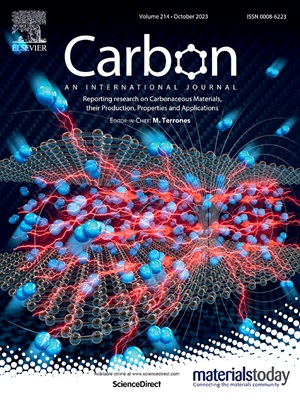A review on the arylation of carbon nanomaterials: fabrication, characterization, and applications in energy storage and conversion devices
IF 10.5
2区 材料科学
Q1 CHEMISTRY, PHYSICAL
引用次数: 0
Abstract
Arylation of carbon nanomaterials (CNMs) involves the covalent functionalization of carbon materials with arenes and has emerged over recent decades as a prominent strategy for tailoring CNMs for diverse purposes. Arylation of CNMs constructs robust C–C sp3 bonds between exogenous aromatic molecules and carbon nanomaterials, enhancing chemical stability, solubility, electronic properties, and material compatibility. Moreover, aromatic precursors with different functional groups can be synthesized to deliver bespoke functionalized carbon substrates for designated purposes, further broadening applications in energy storage and conversion. This review summarizes the most commonly adopted strategies for the arylation of CNMs, including the use of aryl diazonium salts, diaryl iodonium salts, various cycloaddition methods exploiting arynes, 1,3-dipoles, nitrenes, and bromo mannonates. The development of each approach has been systematically reviewed, in addition to highlighting the advanced characterization techniques employed for these functionalized CNMs and their applications in energy systems. Furthermore, potential challenges and future perspectives in the arylation of CNMs are discussed, emphasizing the need for continued research in this evolving field.

综述了碳纳米材料芳基化的制备、表征及其在储能和转换器件中的应用
碳纳米材料(cnm)的芳基化涉及碳材料与芳烃的共价官能化,近几十年来已成为定制cnm用于各种用途的重要策略。cnm的芳基化在外源芳香分子和碳纳米材料之间构建了强大的C-C sp3键,增强了化学稳定性、溶解度、电子性能和材料相容性。此外,可以合成具有不同官能团的芳香族前驱体,为特定目的提供定制的功能化碳底物,进一步扩大在能量储存和转化方面的应用。本文综述了CNMs最常用的芳基化策略,包括芳基重氮盐、二芳基碘盐的使用,以及利用芳炔、1,3偶极子、亚硝基和甘露糖酸盐的各种环加成方法。除了强调这些功能化cnm及其在能源系统中的应用所采用的先进表征技术外,还系统地回顾了每种方法的发展。此外,本文还讨论了CNMs芳基化的潜在挑战和未来前景,强调了在这一不断发展的领域继续研究的必要性。
本文章由计算机程序翻译,如有差异,请以英文原文为准。
求助全文
约1分钟内获得全文
求助全文
来源期刊

Carbon
工程技术-材料科学:综合
CiteScore
20.80
自引率
7.30%
发文量
0
审稿时长
23 days
期刊介绍:
The journal Carbon is an international multidisciplinary forum for communicating scientific advances in the field of carbon materials. It reports new findings related to the formation, structure, properties, behaviors, and technological applications of carbons. Carbons are a broad class of ordered or disordered solid phases composed primarily of elemental carbon, including but not limited to carbon black, carbon fibers and filaments, carbon nanotubes, diamond and diamond-like carbon, fullerenes, glassy carbon, graphite, graphene, graphene-oxide, porous carbons, pyrolytic carbon, and other sp2 and non-sp2 hybridized carbon systems. Carbon is the companion title to the open access journal Carbon Trends. Relevant application areas for carbon materials include biology and medicine, catalysis, electronic, optoelectronic, spintronic, high-frequency, and photonic devices, energy storage and conversion systems, environmental applications and water treatment, smart materials and systems, and structural and thermal applications.
 求助内容:
求助内容: 应助结果提醒方式:
应助结果提醒方式:


